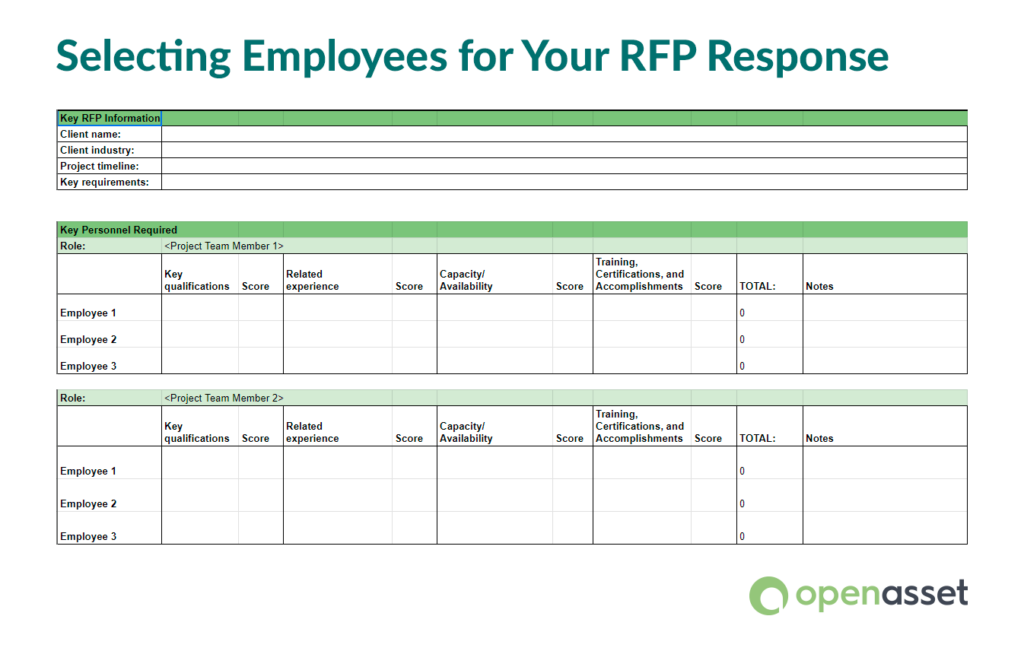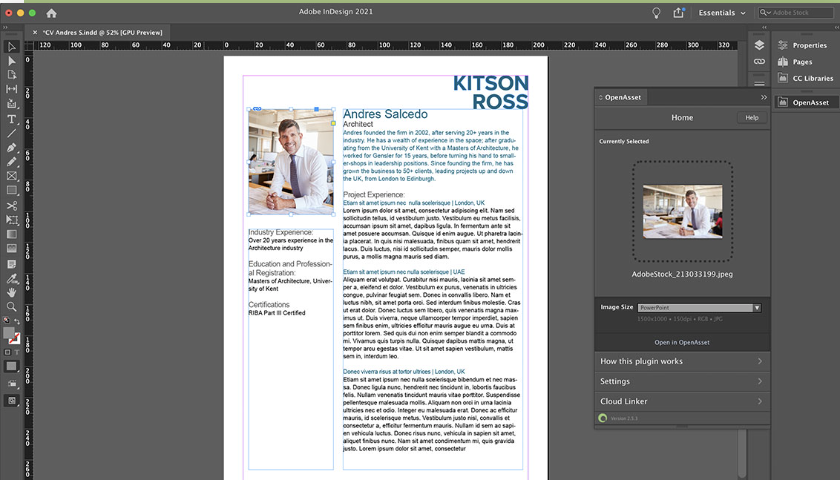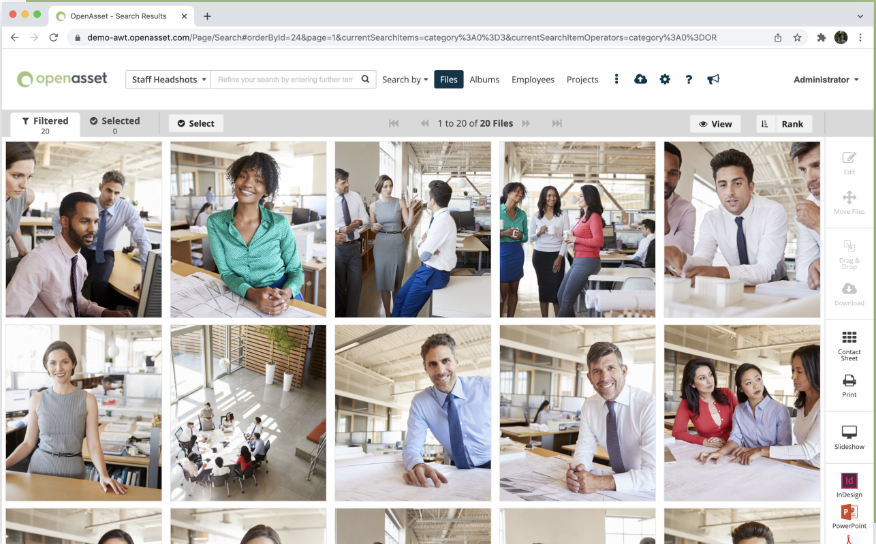In the Architecture, Engineering, and Construction (AEC) industry, every proposal is an opportunity to land a new project. At the heart of every successful proposal is not just the solution you offer but the people who stand behind it. Responding to an RFP isn’t just about showcasing your firm’s capabilities; it’s about presenting a team that can turn vision into reality.
In a competitive bidding environment, demonstrating the achievements and expertise of individuals can go a long way. As you complete your proposal, choosing the appropriate key employees is a crucial step in showing your client that both your team and solution fulfill every aspect of the project’s demands.
But how do you know you’re selecting the best employees for your RFP responses? In this blog, we’ll go over the strategy of selecting the right staff for your proposals, ensuring your RFP response stands out among the competition.
What Employees Should I Include in My RFP Response?
When preparing a response to a Request for Proposal (RFP), including specific employees or team members in your response often depends on the nature of the project and the requirements outlined in the RFP.
To guarantee you’re selecting the proper employee for every RFP response, you should first follow the guidelines of the RFP. Typically, an RFP will specify the particular roles they expect you to provide. Be it a Project Manager, Lead Architect, Sustainability Expert, or Civil Engineer, every proposed individual should align with the qualifications and experience outlined in the RFP.
You should select individuals with the most relevant and extensive professional experience. To do this, you need to consider and take note of their notable achievements and the potential value they bring to the project.
That said, when responding to an RFP in the AEC industry, you’ll typically need to present a team that represents a diverse range of expertise to make sure all aspects of the potential project are covered. Here are some of the key employee roles you might include in your AEC RFP response:
- Project Manager (PM)
- Architects
- Engineers (Structural, Mechanical, Electrical, Civil, etc.)
- Construction Manager
When including these employees in your RFP response, it’s important to provide a brief profile of each, highlighting their qualifications, relevant project experience, certifications, and any other attributes that position them as the best fit for the project. This helps in building trust and confidence in your firm’s capabilities.
| TIP: Looking for more ways to ensure your AEC proposal maximizes every business opportunity? Get your free Ultimate AEC Proposal Checklist now. |
Factors in Selecting the Employees for Your AEC Proposal
Selecting the right employees for your AEC proposals is crucial, as the quality and experience of your employees often act as key differentiators in a competitive bidding process. Here are the factors you should take into account when selecting employees for your AEC proposal:
Key Qualifications
The primary goal in an RFP response is to demonstrate that your company has the skills, experience, and employees necessary to successfully complete the project. Picking your RFP employees based on the specific requirements and qualifications outlined in the RFP shows your commitment to meeting the client’s needs.
You should always tailor your response accordingly, and always be transparent and honest about the capabilities of your team.
When looking for key qualifications, consider degrees or formal education related to the project, such as architecture, civil engineering, or construction management. Additionally, depending on the project’s details, technical skills can range from proficiency in specific software tools to hands-on construction or design expertise.
It’s important to emphasize the responsibilities tied to past projects and focus only on tasks relevant to the role being proposed. Check for a seamless flow from one position to the next without any gap years. Moreover, remember to incorporate data and evidence-backed points within the employment history area.
Related Experience
Given that your client will interact with the employees mentioned in your RFP proposal daily, it’s crucial to highlight the value of your suggested employees. One way to do this is by highlighting relevant work experience.
Ask yourself, does the individual have experience with projects of similar scale, complexity, or domain? Has the person had the same role on similar projects? For instance, has your proposed project manager successfully managed large-scale construction projects before?
Taking this approach serves as an important move in assuring the client of the employee’s capability to not only meet but surpass the project’s expectations. Not only should you be emphasizing the employee’s value, but you should show how their experience and knowledge will lead to a successful project.
Highlight their demonstrated capability to fulfill project demands in assignments of comparable scale, scope, and complexity. Use this chance to extract and spotlight duties from previous roles, showcasing their expertise in the industry.
Who Has the Capacity and Availability?
When choosing employees for your AEC proposal, you need to fulfill the promise if the work does go through. This means you must consider capacity planning and who has the experience.
Make sure that the proposed employees have the bandwidth to handle the new project. Remember, overcommitting can lead to burnout and can damage project quality and timelines.
It’s crucial to find a balance between experience and availability. While you might want your most experienced architect on a project, if they’re already committed elsewhere, it’s better to propose someone else who isn’t already committed. The individuals you’re committing to the project must be available for its expected duration. Any changes post-selection can create issues with the client.
Training, Certifications, and Accomplishments
Before picking key employees for an RFP response, ask yourself: How big is the opportunity? Do any employees have standout accomplishments or certifications that can act as third-party proof points?
Look for any specialized training that might be relevant. This could be in areas like sustainable construction, Building Information Modeling (BIM), or safety protocols. Regular refresher training or recent courses can also indicate a commitment to staying updated in the field.
When it comes to industry-standard certifications, LEED for green building projects or PMP for project managers are some examples of certifications that can add weight to your proposal. All certifications should be updated and valid.
Moreover, when proposing employees for a significant project, highlighting any awards, recognitions, or standout achievements they’ve had with projects of a similar or larger scale can be beneficial. However, it’s important to provide evidence or examples that prove those achievements.
For example, instead of simply stating you “completed projects,” you might specify that you “successfully finalized three commercial building projects ahead of schedule in Q4 of 2020 compared to two in Q4 of 2019.”
If you’ve effectively managed a construction site with a large number of contractors and subcontractors or won industry-specific accomplishments, such as the ‘AEC Project Manager of the Year’ award, mention it.
| TIP: Need a DAM to help you create employee resumes in seconds? Find the right DAM for your team by reading our DAM Software Buyer’s Guide now. |
Scope of Work
When choosing the right employees, you should collect data on key employees. A Scope of Work (SOW) checklist helps you with the process, making it a valuable resource. List every section of the SOW and evaluate whether your suggested employees align with the RFP guidelines and have experience managing comparable tasks.
The checklist should include all SOW segments and detail the individual’s experience, duration, and contributions to projects of similar scope.
Additionally, when a company or client provides an SOW, it often contains specific keywords or terms that detail what they’re looking for. You should naturally incorporate these specific keywords or terms from the SOW into your RFP resume.
Doing so demonstrates that your skills and experience align closely with what the company or client is seeking.
Decision Matrix: Selecting Employees for Your RFP Response
Creating a Decision Matrix helps the team in selecting the best employee for a role. It’s an effective way to select the best employees for your RFP response, especially in the AEC industry.
This tool helps in comparing potential candidates based on specific criteria that are important for the success of the proposal. It should include essential program credentials, including a qualifications overview, any relevant experience, and the other factors previously mentioned.
A decision matrix works by having you identify factors you’ll use to evaluate each employee. You will then rate each employee on a scale and rank the employees based on their total scores. Those with the highest scores will be the most suitable for inclusion in the RFP response.
The criteria you choose should truly reflect the needs of the project and the expectations outlined in the RFP. The matrix is a guide but doesn’t replace human judgment. Remember to always consider other factors like team dynamics and client preferences.
Here’s an example of what a Decision Matrix looks like:

Create Flawless Employee Resumes Faster Than You Think
Your employee resumes aren’t just summaries of qualifications – they’re powerful tools that showcase your team’s potential. And with OpenAsset, a Digital Asset Management (DAM) solution for the built world, crafting the perfect RFP resumes is more streamlined than ever.
With OpenAsset’s specialized Employee Module, you’re not just creating a resume; you’re creating a story. Whether it’s a seasoned architect with years of iconic builds or a young engineer with fresh, transformative ideas, every detail matters. OpenAsset helps you create flawless employee resumes that win business.
The Employee Module drives efficiency within your organization by automating the creation of resume documents and allowing you to automatically synchronize employee data between OpenAsset and your CRM or ERP system.


Ready to create flawless RFP resumes in seconds? With OpenAsset, achieve perfection efficiently. Schedule a demo to learn more about how OpenAsset can help you create RFP responses that make you stand out from the endless pile of proposals.



